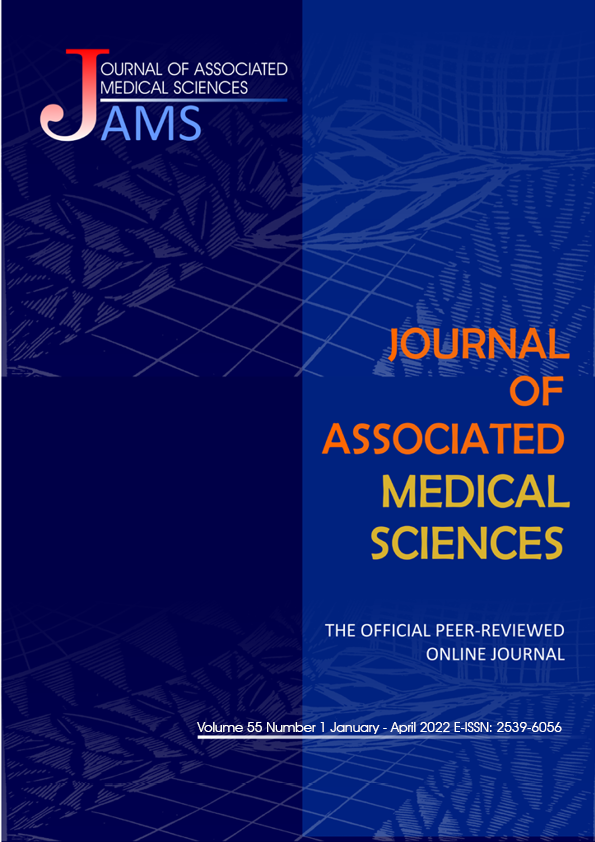Psychometric properties of the apraxia of speech rating scale Thai version
Main Article Content
Abstract
Background: Thai speech-language pathologists lack appropriate tools to describe apraxia of speech (AOS) characteristics in Thai patients.
Objectives: This study aimed to translate and adapt the most recent version of the Apraxia of Speech Rating Scale (ASRS) 3.3, the ASRS 3.3, into a Thai version and evaluate the psychometric properties of the Thai version (ASRS-Thai).
Materials and methods: The original ASRS 3.3 has been translated into Thai using the backward-translation approach. The original developer was also included in the translation process to improve the translation accuracy. The resulting tool, ASRS-Thai, was administered to 28 adults with neurological speech or language disorders, along with another AOS test available in Thai, Apraxia Test for Thai Adults (ATTA). The recordings were rated independently by 5 experienced speech-language pathologists at different hospitals. The clinical assessment of patients’ performance on the ATTA was used as the reference standard to measure the sensitivity and specificity of ASRS-Thai for AOS diagnosis. Concurrent validity and reliability measures were also examined. Reliability was examined by evaluating intra-rater and inter-rater reliability.
Results: Moderate-to-strong negative correlations were found between the ATTA and the ASRS-Thai (-0.575 to -0.900). Additionally, the sensitivity and specificity of the ASRS-Thai at a cut-off score of 16 were 100% and 86.7%, respectively. Reliability was computed by measuring the intraclass correlation (ICC) values. The intra-rater ICCs were 0.96, 0.968, and 0.976, and the inter-rater ICC was 0.927 for the total score.
Conclusion: The ASRS-Thai is a reliable, valid instrument to describe the presence and severity of AOS characteristics in clinical settings and research. Additional data collection by testing a larger sample size with diverse severities, including cases of pure AOS, is warranted in future studies.
Article Details

This work is licensed under a Creative Commons Attribution-NonCommercial-NoDerivatives 4.0 International License.
Personal views expressed by the contributors in their articles are not necessarily those of the Journal of Associated Medical Sciences, Faculty of Associated Medical Sciences, Chiang Mai University.
References
Duffy JR. Motor Speech Disorders: Substrates, Differential Diagnosis, and Management. 3rd ed. St. Louis, MO: Elsevier Mosby; 2013.
Jariengprasert C. Speech therapy in cerebrovascular disease patient with communication problems. Vichaiyut newsletter. 2005 (in Thai).
Gross RG, Grossman M. Update on apraxia. Curr Neurol Neurosci Rep. 2008; 8(6): 490-6. doi: 10.1007/s11910-008-0078-y.
Suwanwela N. Stroke Epidemiology in Thailand. J Stroke. 2014; 16(1): 1-7. doi: 10.5853/jos.2014.16.1.1.
Kongbunkiat K, Kasemsap N, Thepsuthammarat K, Tiamkao S, Sawanyawisuth K. National data on stroke outcomes in Thailand. J Clin Neurosci. 2015; 22(3): 493-7. doi: 10.1016/j.jocn.2014.08.031.
Wertz RT, LaPointe LL, Rosenbek JC. Apraxia of speech in adults: The disorder and its management. Orlando, FL: Singular publishing; 1984.
Polanowska KE, Pietrzyk-Krawczyk I. Post-stroke pure apraxia of speech–a rare experience. Neurol Neurochir Pol. 2016; 50(6): 497-503. doi: 10.1016/j.pjnns.2016.08.005.
Jonkers R, Feiken J, Stuive I. Diagnosing Apraxia of Speech on the Basis of Eight Distinctive Signs. Can J Speech Lang Pathol Audiol. 2017; 41(3): 303-19.
Ziegler W, Aichert I, Staiger A. Apraxia of Speech: Concepts and Controversies. J Speech Lang Hear Res. 2012; 55(5): S1485-S501. doi: 10.1044/1092-4388(2012/12-0128).
Darley FL, Aronson AE, Brown JR. Motor speech disorders. Philadelphia: WB Saunders Company; 1975.
Akamanon C. The Apraxia test for Thai adults. Bangkok: Ramathibodi Hospital; 1988.
Sarankawin C. The apraxia test for Thai adults performances of subjects aged 20 to 65 years [thesis]. Bangkok: Mahidol University; 2002.
Dabul B. ABA-2: Apraxia Battery for Adults–Second Edition. Austin, Texas: PRO-ED; 2000.
Tanner D, Culbertson W. Quick assessment for apraxia of speech. Oceanside, CA: Academic Communication Associates; 1999.
Shipley KG, McAfee JG. Assessment in speech-language pathology: A resource manual. 6th ed. Plural Publishing; 2019.
Strand EA, Duffy JR, Clark HM, Josephs KA. The Apraxia of Speech Rating Scale: a tool for diagnosis and description of apraxia of speech. J Commun Disord. 2014; 51: 43-50. doi: 10.1016/j.jcomdis. 2014.06.008.
Kertesz A. Western Aphasia Battery - Revised (WAB-R). Austin, TX: PRO-ED; 2006.
Santibanez J. Differentiation of the presence and severity of apraxia of speech in English and Spanish speakers [thesis]. University of Texas at Austin; 2016.
Utianski RL, Duffy JR, Clark HM, Strand EA, Botha H, Schwarz CG, et al. Prosodic and phonetic subtypes of primary progressive apraxia of speech. Brain Lang. 2018; 184: 54-65. doi: 10.1016/j.bandl.2018.06.004.
Wambaugh JL, Bailey DJ, Mauszycki SC, Bunker LD. Interrater Reliability and Concurrent Validity for the Apraxia of Speech Rating Scale 3.0: Application With Persons With Acquired Apraxia of Speech and Aphasia. Am J Speech Lang Pathol. 2019; 28(2s): 895-904. doi: 10.1044/2018_AJSLP-MSC18-18-0099.
Clark HM, Duffy JR, Strand EA, Utianski RL, Josephs KA. The Apraxia of Speech Rating Scale 3.3. Unpublished document; 2018.
Beaton D, Bombardier C, Guillemin F, Ferraz MB. Recommendations for the cross-cultural adaptation of health status measures. Am Acad Orthop Surg. 2002: 1-9.
Brislin RW, Lonner WJ, Thorndike RM. Cross-cultural research methods. New York:John Wiley & Sons; 1973.
MacCarrick G. Medical Leadership and Management A Case-based Approach. London: Springer; 2014.
Gandour J, Dardarananda R, Potisuk S, Holasuit S. Thai adaptation of the Western Aphasia Battery (WAB). Chiang Mai University; 1994.
Teerapong W. The comparison of language abilities of Thai aphasic patients and Thai normal subjects by using Thai adaptation of Western Aphasia Battery [thesis]. Bangkok: Mahidol University; 2000.
Chan YH. Biostatistics 104: correlational analysis. Singapore Med J. 2003; 44(12): 614-9.
Zhou X-H, McClish DK, Obuchowski NA. Statistical methods in diagnostic medicine. 2nd ed. New Jersey: John Wiley & Sons; 2009.
Swets JA. Signal detection theory and ROC analysis in psychology and diagnostics: Collected papers. New York: Psychology Press; 2014.
Koo TK, Li MY. A Guideline of Selecting and Reporting Intraclass Correlation Coefficients for Reliability Research. J Chiropr Med. 2016; 15(2): 155-63. doi: 10.1016/j.jcm.2016.02.012.
Duffy JR, Josephs KA. The Diagnosis and Understanding of Apraxia of Speech: Why Including Neurodegenerative Etiologies May Be Important. J Speech Lang Hear Res. 2012; 55(5): S1518-S22. doi: 10.1044/1092-4388(2012/11-0309).
Wu SM, Whiteside U, Neighbors C. Differences in Inter‐Rater Reliability and Accuracy for a Treatment Adherence Scale. Cogn Behav Ther. 2007; 36(4): 230-9. doi: 10.1080/16506070701584367.


